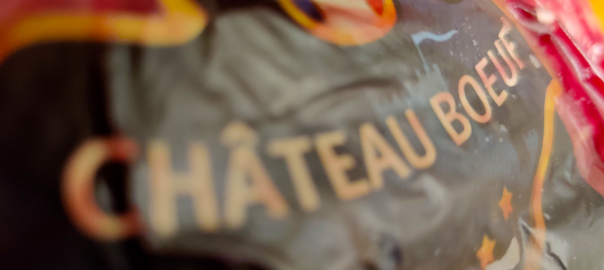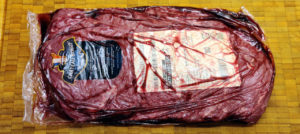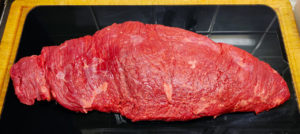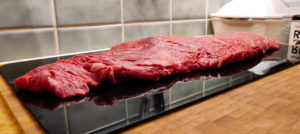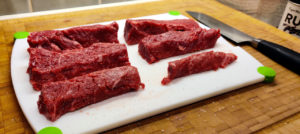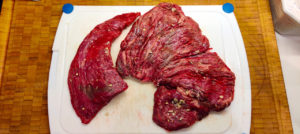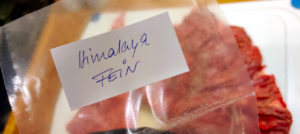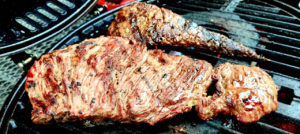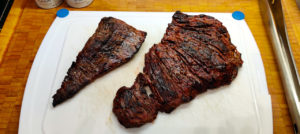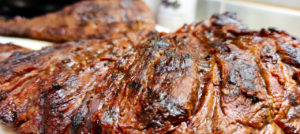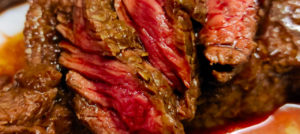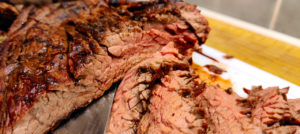Even when it comes to the traditional steak, the eye & palate need a change now and then. In the last few years, new trends for more or less unusual cuts have been popping up on the horizon. This is also the case with the Flank Steak, which has been “on everyone’s lips” for a while now. Today I had the first Flank Steak of the brand Château Boeuf – a “Bavette aloyaux “– a really huge piece of meat.
Just like the hanging tender (Onglet), the Flank Steak – in the case of this French brand, ‘Bavette’ for short – has very long and strong muscle fibres, which is why it requires “special attention” regarding the temperature during grilling. In contrast to the hanging tender (Onglet), there are, thank God, two Bavettes per animal (whether beef, buffalo or bison), which ideally have no tendons.
Of course, I “freed” the Bavette from the foil with sufficient lead time, dabbed it off and put it ready in the kitchen. Especially with such a long fibrous cut, it makes a big difference at what temperature it lands on the grill.
At this point very briefly in own business:
What kind of cutting board do you prefer? The good classic wooden board (which wood?) with a juice groove, one of the common plastic variants as we know it from the meat counter or maybe a cutting board made of ceramic, marble or glass?
Personally, I currently use one made of plastic with a juice groove, but I don’t think it is really easy to clean. What I am looking for is the “all-in-one device suitable for every purpose”, i.e. a cutting board that I can use for all kinds of meat (also poultry). It must be 100% cleanable without much effort, no material should be removed when I work on it with a really sharp knife and it should have a proper juice groove.
Have you seen anything suitable for the requirements mentioned or even in use? I would be very happy if you let me know via Facebook Message if you can help me with the search. Thanks a lot, in advance – but now back to the Bavette .
When the meat was at room temperature, I salted it and seasoned it with two fresh, chopped cloves of garlic before adding a little extra virgin olive oil. As always, I tried a new salt for the Bavette – in this case I chose fine Himalayan salt.
This delicate pink rock salt is used for cooking as well as for seasoning at the table and can be portioned very well due to its fine grain size. The pink colour of this salt is due to the high pressure and the storage of iron.
Now it was time for the grill. At the beginning I worked with the maximum temperature of my little Landmann – according to the built-in thermometer it is around 400°C. So, I was able to give the meat some nice stripes in addition to the beloved roasting aromas.
Afterwards I went down with the temperature (100°C to 120°C) to avoid that the meat fibres shrink too much. The good piece should neither become hard nor dry. I have – as so often lately – completely renounced pepper. I am increasingly enjoying the unadulterated taste of high-quality meat “pure”.
It is important to me – and not only because of the current press – that the meat that ends up on my plate was produced according to animal welfare aspects. I am not necessarily concerned with specific labels – companies from other European countries in particular have very different approaches to this than we do here in Germany.
Above all, transparency from rearing to the service counter is a must! It should be ensured that the animals always had sufficient space and that the calves could stay with their mothers as long as possible. In addition, the animals must have been fed in a manner appropriate to their species and there should be no stress either during rearing or slaughter.
I think that Scotland is exemplary in the way this issue is dealt with. The Scots know about the excellent reputation of their farm animals – whether beef, lamb or pig – and have been living an ethically responsible line for many years. “Class-Primus” here is in my opinion still SCOTLAND HILLS, and yes, I have to admit – this brand has made me particularly fond of taste.
But now back to our grilled Bavette . A good part of it we “breathed” directly without adding any seasoning or sauces. Here the cooking degree was medium, whereby we had put aside a part English grilled for the later use in a Thai beef salad. You can find the corresponding recipe here – the recipe is with DUROC, but it works great with any grilled meat, even with the Bavette .
The bite of the medium grilled part of the Bavette was a bit firmer than expected, but not too firm yet. The taste is a bit like steak rump – so the aroma is rather neutral. Luckily the garlic added before did its job well and made sure to leave a fine aroma throughout the grill – otherwise we would have had to use spices and sauces after all.
My conclusion about the Bavette – it tasted good, but didn’t knock my socks off. On the other hand, I found the hanging tender much more aromatic and would prefer a more marbled part like the entrecôte or picanha. For the Thai salad it worked very well with cooking degree “English” and cut very thin.
So far from Berlin – enjoy the barbecue time, try something different – for example the grilled melon with goat cheese – but above all stay healthy and have fun cooking!
*The fine Himalayan salt used here – and many other delicious salts – are also available at Salmundo.
